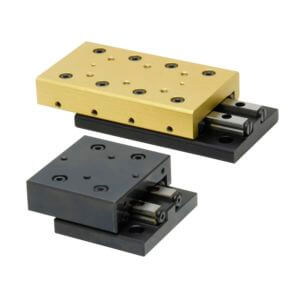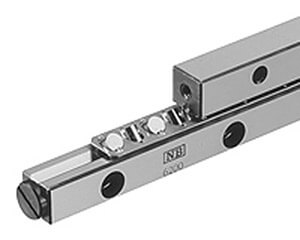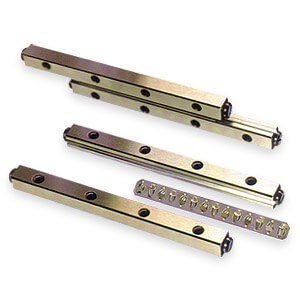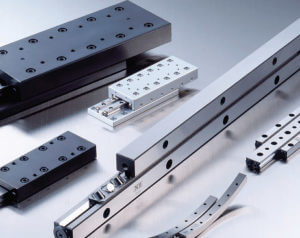Important Factors to Consider When Choosing a Crossed Roller Slide or Table Assembly
October 7th, 2022 by David Casillo. Product NewsCrossed Roller Bearings vs. Ball Bearings

Crossed roller slide tables
When referring to linear bearings, we generally think of devices that incorporate ball bearings – meaning friction is reduced between moving parts by recirculating balls. Bushings, ball splines, linear guides, and slides typically incorporate recirculating ball bearings.
As technology has become more demanding and requiring greater precision, however, reliance another type of linear bearing, the crossed roller, has dramatically increased. Crossed roller bearings can be found in a broad range of applications including medical and lab equipment; machine tools, semiconductor and electronics manufacturing; clean rooms and vacuum environments; material handling, vision inspection, robotics and automation machinery.
Crossed roller bearings provide more accuracy, rigidity, and weight-bearing capacity for linear motion than other commonly used friction-reducing devices such as ball bearings. And unlike ball bearings, they can support moment loads, radial forces or tilting loads. This lets one crossed roller bearing replace more than one ball bearing, thus saving the space required by ball bearings, lowering the associated material costs.
Crossed roller bearings are preferred for high-precision linear-motion applications with relatively short linear movements that require smooth motion. They are also extremely durable, lasting 150 million cycles, even for linear-motion applications with high levels of acceleration and deceleration when using 2 to 12-mm rollers and 30 to 600-mm lengths.
Crossed Roller Bearing Basics

Rollers nest in V-groove and are crisscrossed at 90° angles
Crossed roller slides and tables are linear bearings that use cylindrical rollers — as opposed to balls — to carry a load. In these mechanisms, also known as crossed-roller bearings, cylindrical rollers are sandwiched between two parallel guides called the table and bed. Here, the rollers nest in V-grooved raceways ground out of the guides, and crisscross at 90° angles (hence the term “crossed’).
Because of crossed rollers large contact area, they deform less than recirculating ball bearings and are stiffer, creating more precise and consistent motion. In addition, this consistent (slip-free) contact between carriage and base reduces wear.
The configuration of a cross roller bearing gives designers all the benefits of a two-row bearing, including stability, in a single-row space as the alternating rollers can support loads from all directions, including high overturning moments.
Metal vs. Plastic Cages
To control their motion, the rollers are held inside a cage that can be made of either plastic or metal. The cage prevents roller-to-roller contact, thus reducing friction and avoiding premature wear of the rollers.
Traditional metal cages use tabs on the carriage that fit into notches on the top and bottom of the rollers to keep them in place. While less expensive to manufacture, this limits how closely a roller can be positioned together, which in turn limits the crossed roller bearing’s load-carrying capacity.
In addition to plain steel, metal cages are offered in stainless which is a better solution for in high-temperature, washdown, and medical applications where rust is unacceptable. Metal is also more suitable for applications that take place in a cleanroom or a vacuum, since resin can degrade sensitive environments through outgassing.
Resin cages allow rollers to be spaced more tightly, for at least 30 to 58% increase in contact area as compared to metal cages — allowing for more rollers per inch — and an increase in load capacity of up to 250%.
Preventing Cage Creep

The cage “floats” between the bearings rails
An important consideration when choosing a crossed roller slide or table is a phenomenon called cage creep. Because the cage floats between the bearing’s rails, it can drift from its longitudinal center over time – especially in applications where the slide is mounted vertically or if the linear bearing only makes partial strokes. Vibrations and shock can also induce cage creep.
When creep occurs, the cage can restrict slide travel — because once the bearing makes its next full stroke, an off-center cage will hit a rail endstop and is forced to skid, to center itself again. Hitting the endstop and skidding can damage the retainer, rollers, and slideway. Cage creep also means the rollers are not rolling but slipping and causing metal-to-metal rubbing, which leads to wear.
Fortunately, there are anti-creep mechanisms that stop retainers from slipping by holding the rollers between the two V-grooved slideway rails. As a result, the rails can be used in any mounting orientation. Anti-creep devices also reduce downtime and the cost of maintenance.
Travel Lengths
One limit on the choice of a crossed roller bearing is the space available in the application. With a recirculating ball bushing the shaft must only be as long as the required travel, because only the bushing moves. In contrast, with a crossed-roller bearing, the rail assembly (and workspace available) must be twice as long as the application’s travel length — because the two rails that contain its rollers move in opposite directions.
When the bearing uses plastic cages, however, the stroke length can be longer on a given length of rail because the cage can be shorter for a given load.
Accuracy
To make them suitable for high-precision applications and to eliminate clearance between the rollers and guides, crossed roller slides are typically manufactured with preload. In addition, mounting surfaces are precision machined for flatness and parallelism. if accuracy is paramount, it is important to select bearings with a margin of extra load capacity. That’s because rollers and rails can deform when nearing their load limits, which can change the accuracy, sometimes permanently.
Isotech Crossed Roller Slide and Table Assemblies

Isotech offers slides from Deltron and NB
Isotech’s Crossed Roller Slides and Tables offer engineers and designers crossed roller bearing technology for their applications. Our crossed roller bearings offer several levels of precision ranging from a straight line accuracy of 0.0008″ to 0.0000040″ per inch of travel. Load carrying capabilities range from several pounds to in excess of 2600 lbs. Available with inch or metric holes and hole locations these factory preloaded, low friction, light weight crossed roller slide and table assemblies are ready for installation right out of the box.
- Low friction, straight-line design reduces the coefficient of friction to 0.003
- Rollers improve load capacity 8-10 times that of balls
- Alternately crossed rollers handle force in any direction
- Factory preload adjustment prevents side-play and backlash
- Built-in holes simplify installation and component mounting
- Available in varying precision grades and corrosion resistant materials
Crossed Roller Slides Models & Specifications
Crossed Roller Tables Models & Specifications
Categories
Keywords
Copyright© 2025 Isotech, Inc. All rights reserved.
